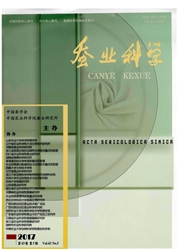

 中文摘要:
中文摘要:
原生质体融合(protoplast fusion)技术是将遗传性状不同的亲本原生质体融合杂交的基因重组技术。从健康桑树根系中分离到一株产油脂内生真菌MOD-1,采用酶解方法制备内生真菌MOD-1和产纤维素酶菌株绿色木霉TP4、T44及长柄木霉TL的原生质体,获得4个菌株的原生质体产量分别为7.02×10^6个/m L、4.43×10^6个/m L、6.35×10^6个/m L和4.35×10^6个/m L,再生率分别为4.90%、3.26%、4.51%和4.12%。优化亲本原生质体灭活条件为:MOD-1菌株经紫外线照射10 min或加热15 min,TP4菌株经紫外线照射25 min或加热20 min,T44菌株经紫外线照射25 min或加热25 min,TL菌株经紫外线照射30 min或加热25 min。在上述条件下各亲本原生质体的灭活率均达到100%。将灭活的MOD-1菌株原生质体分别与不同方式灭活的TP4、T44、TL菌株原生质体融合,经初筛和复筛获得了一株兼具MOD-1与TP4双亲优良性状的融合菌株MP-1,其油脂产量、油脂含量(质量分数)分别为0.082 4 g/L、14.46%,显著高于亲本菌株MOD-1。融合菌株MP-1传代培养10代后,油脂产量与油脂含量的遗传稳定性分别达到92.84%和95.00%。
 英文摘要:
英文摘要:
Protoplast fusion is a kind of gene recombination technology which fuses parental protoplasts that have differ- ent genetic traits to achieve the purpose of hybridization. A lipid-producing endophytic fungus MOD-1 was isolated from healthy mulberry root. Using enzymatic hydrolysis method, protoplasts of mulberry endophytic oleaginous Macrophomina phaseolina MOD-1, cellulase-producing strains including Trichoderma viride TP4, T44 and Trichoderma Iongibrachiatum TL were obtained. The protoplast yield of MOD-1, TP4, T44 and TL strains reached 7. 02×10^6 mL^-1, 4. 43×10^6 mL^-1, 6.35×10^6 mL^-1 and 4.35×10^6 mL^-1 respectively, and the regeneration rate reached 4.90%, 3. 26%, 4.51% and 4. 12% respectively. The optimized inactivation conditions of parental protoplasts were as follows: MOD-1, UV-irradiation for 10 rain or heat-inactivation for 15 min; TP4, UV-irradiation for 25 min or heat-inactivation for 20 min; T44, UV-irradiation for 25 min or heat-inactivation for 25 min; TL, UV-irradia- tion for 30 min or heat-inactivation for 20 min. Under these conditions, the inactivation rate of parental protoplasts all reached 100%. MOD-1 inactivated protoplast was fused with T44, TP4 or TL inactivated protoplast by different ways, and a fusant MP-1 from MOD-1 and TP4 was ob- tained through primary and secondary screening. Its lipid yield and lipid content (mass fraction) achieved to 0. 082 4 g/L and 14. 46%, being significantly higher than those of parental strains. The genetic stability of lipid yield and lipid content reached 92.84% and 95.00% respectively after 10 generations of subculture.
 同期刊论文项目
同期刊论文项目
 同项目期刊论文
同项目期刊论文
 期刊信息
期刊信息
